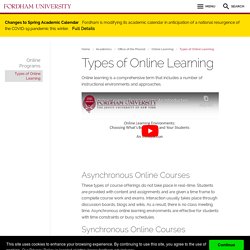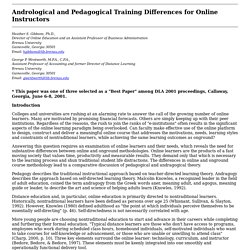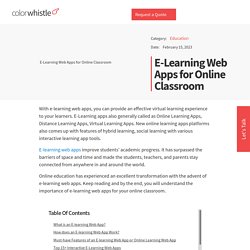

Best Practices in Undergraduate AdultCentered Online Learning Mechanisms for Course Design and Delivery. BEST PRACTICES IN ONLINE EDUCATION Online Instructors Courses and administrators. Comparison of Student and Instructor Perceptions of Best Practices in Online Technology Courses. Types of Online Learning. Online learning is a comprehensive term that includes a number of instructional environments and approaches.

Asynchronous Online Courses These types of course offerings do not take place in real–time. Students are provided with content and assignments and are given a time frame to complete course work and exams. Interaction usually takes place through discussion boards, blogs and wikis. As a result, there is no class meeting time. Synchronous Online Courses These types of course offerings require the instructor and all enrolled students to interact online simultaneously.
Hybrid Courses Hybrid courses, also known as blended courses, are learning environments that allow for both in–person and online interaction. For help with putting part of your course online, or if you would like to be enrolled in an online asynchronous training about designing online course content, contact Steven D'Agustino, the Director of Online Learning at dagustino@fordham.edu. Providing Continuity Creating Content. Andrological and Pedagogical Training Differences for Online Instructors. * This paper was one of three selected as a "Best Paper" among DLA 2001 proceedings, Callaway, Georgia, June 6-8, 2001.

Introduction Colleges and universities are rushing at an alarming rate to answer the call of the growing number of online learners. Many are motivated by promising financial forecasts. Others are simply keeping up with their peer institutions. Regardless of the reasons, the rush to join the ranks of "e-institutions" often results in the significant aspects of the online learning paradigm being overlooked. Can faculty make effective use of the online platform to design, construct and deliver a meaningful online course that addresses the motivations, needs, learning styles and constraints of nontraditional learners, while achieving the same learning outcomes as onground? 15 Top Interactive E-Learning Web Apps for Online Classroom - ColorWhistle. Today, the education industry has gained better knowledge about the potential of virtual classroom and e-learning web apps.

Virtual classrooms with advanced e-learning web apps have made students access more educational content from anywhere at any time. As web apps have made learning easy for students, many educational institutions have already started embracing it. If you have any plans to build a virtual classroom website, do check out our detailed blog on how to create a virtual classroom website If you get any ideas to build an e-learning web app, then feel free to get in touch with us. At ColorWhistle, we build student-friendly web apps to provide the best learning experiences for your students. Among the curated list, which e-learning web app do you like the most and why? 5 Apps to Enhance Distance Learning in Middle and High School.
Distance learning has become the new norm in education since the advent of school closures as a response to the Covid-19 pandemic, and teachers have adapted—with the help of some truly amazing online applications.

Throughout my three months of distance learning, the following five online education applications were my lifelines; they genuinely helped bring my courses to life when I couldn’t be present in person with my students. If we find ourselves in distance learning mode again this fall, they will be on the front lines of my course delivery. My Essential Distance Learning Apps 1. Flipgrid: Flipgrid is a free online application that allows students and teachers to record short, online videos. Similar to Google Classroom, students join classrooms via a code. Flipgrid is a fantastic oral communication application that is easy to use. 2.